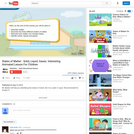
Learn how to pronounce the numbers 0-10 in Spanish!
- Subject:
- Arts and Humanities
- Material Type:
- Interactive
- Date Added:
- 03/16/2018

Learn how to pronounce the numbers 0-10 in Spanish!

A compilation of brief video clips in which native speakers of Spanish from various locations throughout Latin America and Spain demonstrate various language tasks.

This robust set of videos, activity sheets, and short written summaries is designed for anyone to use when integrating speaking assignments and activities into college level courses. Each video highlights a specific student activity, applicable to any delivery mode, complete with a video introduction, template, and lesson plan to download. Open pedagogical opportunities are incorporated into several modules with emphasis on student led engagement. Created by Miranda Hawk at Madison Area Technical College.

See a line up of moons, planets, and stars to give a visual of how Earth compares in size to other bodies in the universe.

Mr. Beaker will help you identifying the states of matter. Be it ice, water or vapor.

This 14-minute video lesson shows how to estimate the probability that the true population mean lies within a range around a sample mean .[Statistics playlist: Lesson 40 of 85]

Paul Anderson's video playlist of videos that can be used in a Statistics and Graphing class

In which Adriene Hill and Jacob Clifford teach you about one of the fundamental economic ideas, supply and demand. What is supply and demand? Well, you’ll have to watch the video to really understand it, but it’s kind of important for everything economically. Supply and demand sets prices, and indicates to manufacturers how much to produce. Also, it has a lot to do with strawberries.

This is a short Ted Talk on similarity unit.

Willow Tufano is only 14, but she's already accomplished something many adults dream of. She's a homeowner! She got her start selling things she found on Craigslist and worked her way up to being able to buy a house! Watch her story here.

This video shows how to tell time in Spanish using "menos" for times between :31 minutes and :59 minutes past the hour.

Students use pitch to explore the characters in a story.

John Orsulak's students work in groups using iodine to test for starch in an array of liquids. Students record and analyze data and conduct the test with their team.

Discussion on explaining parabolas.

Video about the three types of irony: dramatic, situational, and verbal.

Every Friday, TingoEd releases a new vocabulary video to the world. In just two minutes, students will not only master a given word but be engaged by its use in multiple, entertaining contexts.

Paul Andersen takes you on a tour of the cell. He starts by explaining the difference between prokaryotic and eukaryotic cells. He also explains why cells are small but not infinitely small. He also explains how the organelles work together in a similar fashion.

This video segment from Regents Review 2.0 uses a trigonometry equation to determine the height of a flagpole located in front of the school.

A quick plain explanation for blogging with Twitter.

Reconstruction to the Great Depression. Created by Sal Khan.